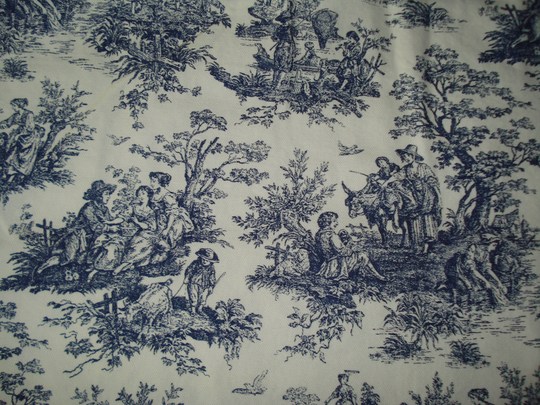
For the Love of Toile
by Lilo Bowman
Toile, or "cloth" in French, has been embraced by interior decorators and clothing designers (and--more recently--quilters) since the 1700s. Inspired by the demand for the exorbitantly priced printed cotton fabrics of India, Irishman Francis Nixon created what would come to be known as the first toile fabric in 1752. His printing technique soon spread to England and France; the French expanded the style and gave the textile its name.
To replicate the Indian prints, Europeans began by dipping a block of carved wood into paint. The paint-dipped block was then pressed onto fabric and struck with a hammer. This method was very time consuming, and did not yield the desired crisp and detailed prints. With the the invention of copperplating in the latter 18th century, fine and detailed designs could be carved and attached to rollers that allowed unending and repeating patterns to be printed onto fabric that was passed between them.

Chateau de l'Eglantine
The most famous toile is Toile de Jouy, created by Christophe-Phillipe Oberkampf, in the village of Jouy-en-Josas near Versailles, France. As a young boy, Christophe was apprenticed to a dyer. In 1760, at age 20, the young man began producing his first fabrics in a small cottage. He was the designer, engraver, and printer. With the advent of the copperplate printing process, the much-loved, one-color prints of mauve, blue, puce, and red came into being. At this same time, new "French" patterns were replacing the traditional Indian motifs. Scenes depicting families picnicking, couples dancing, or idyllic scenes of farm families at work charmed stitchers as much back then as they do in present day.
The love which the people of France feel towards Oberkampf and the printed fabrics he manufactured between the years 1760-1843 has been lovingly preserved in the Chateau de l'Eglantine. Oberkampf's drawing room has been reconstructed to recreate the atmosphere of his residence. It features wooden plates, copper plates and rollers, dyes, and silk-screen printing frames that illustrate the printing processes from the 18th century to the present day. The museum features a collection of over 5000 items relating to Oberkampf, as well as textiles from other French printing factories. To learn more about the museum and its collection, click here.
To view a quick and fun sewing project (Divided Roll Basket) featuring toile, visit Projects here.




.jpg)


